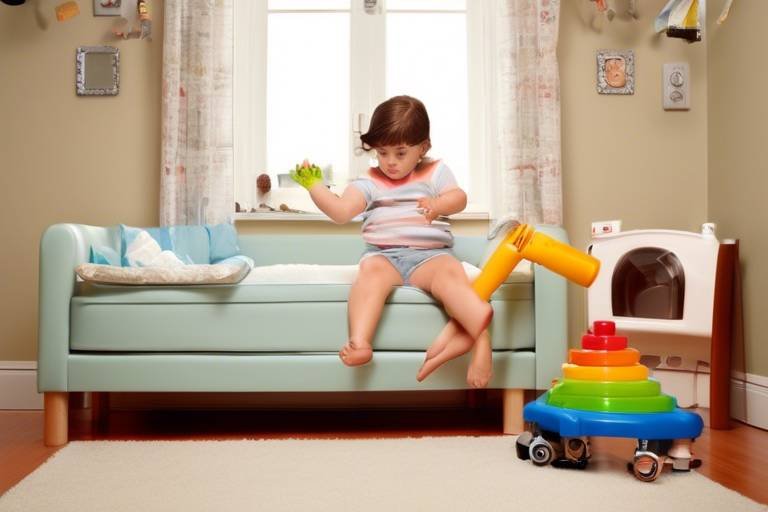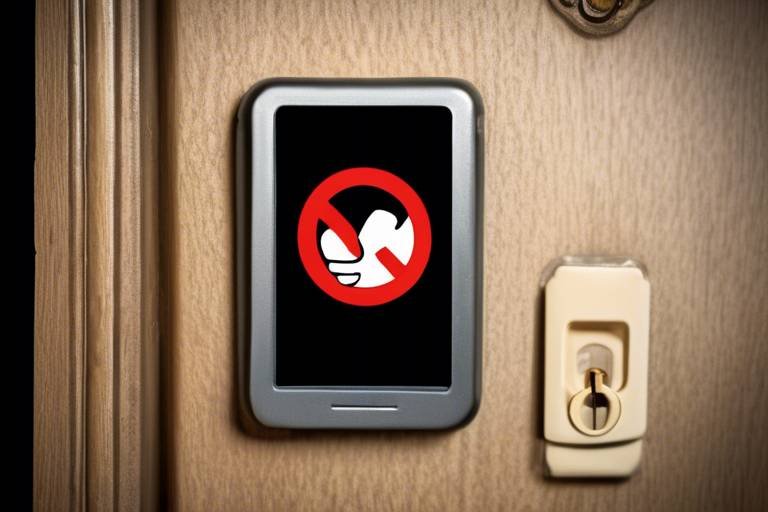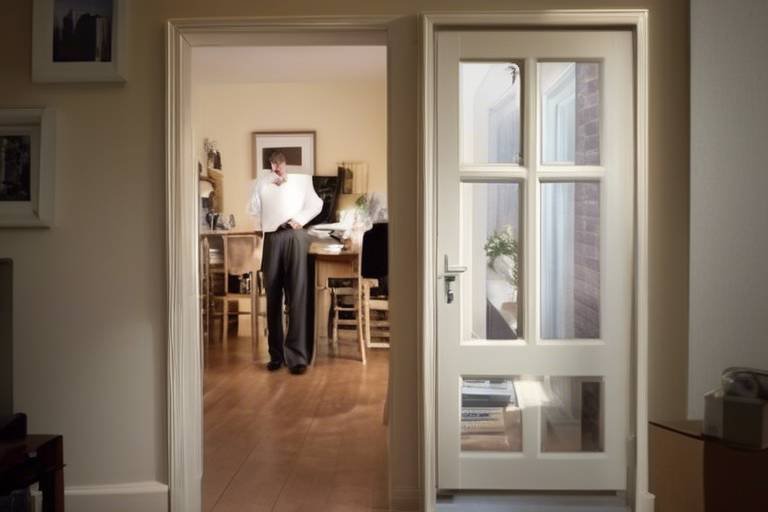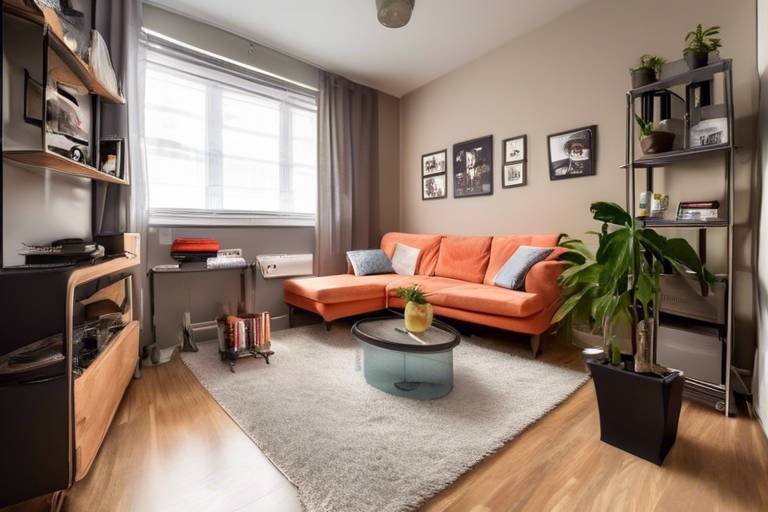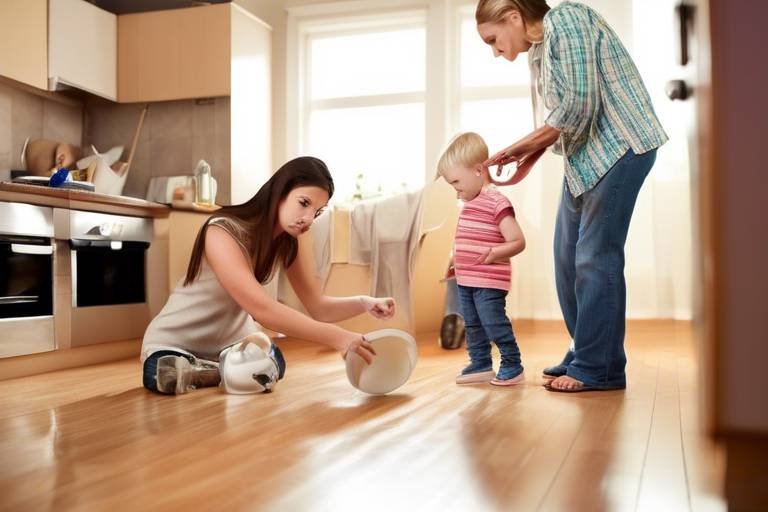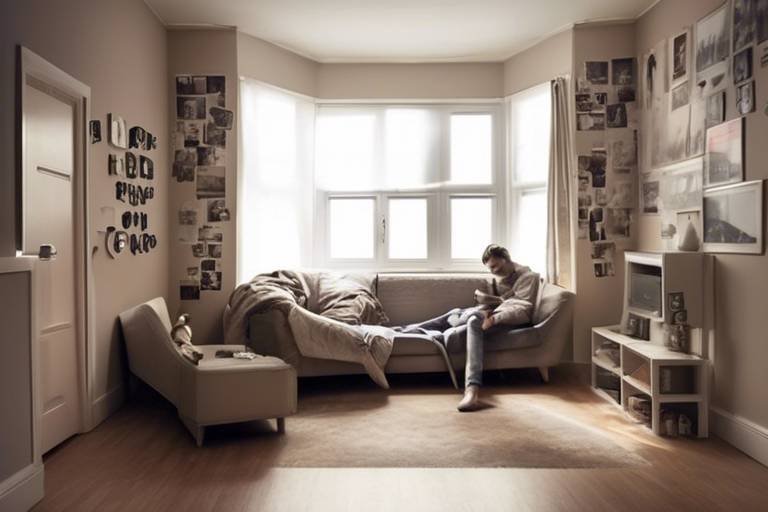Child Safety Features Your Home Should Have
Creating a safe home for your children is not just a priority; it's a necessity. As parents, we often find ourselves overwhelmed with the myriad of responsibilities that come with raising little ones. But amidst the chaos, one thing remains clear: child safety should always come first. From the moment they start crawling to the time they become adventurous toddlers, our homes must be equipped with features that protect them from potential dangers. This article delves into essential safety features that every home should incorporate to ensure a secure environment for children. Whether it’s physical barriers, technological solutions, or simple adjustments in our daily routines, we’ll explore how to effectively safeguard our little ones.
Windows and doors can be a significant risk for children, especially when their curiosity gets the better of them. Implementing safety locks and window guards is not just a good idea; it’s an essential step in preventing accidents. Think about it: how often do we leave windows open for a breeze, completely unaware of the potential dangers lurking? By installing safety locks on windows and using window guards, you can create a barrier that keeps your children safe while still allowing fresh air to circulate in your home.
Electrical outlets are like a magnet for curious toddlers. They are often seen as an intriguing puzzle waiting to be explored. But let’s face it, they can also be a source of danger. Using outlet covers and safety plugs can significantly reduce the risk of electrical shocks, making your home a safer place for children. Imagine your little one reaching for a shiny object near an outlet—scary, right? Outlet covers act as a simple yet effective barrier, ensuring that your child’s exploration doesn’t lead to hazardous situations.
Outlet covers are simple devices that prevent children from inserting objects into outlets. They come in various designs, ensuring that safety doesn’t compromise aesthetics in your home. Some covers blend seamlessly into your decor, while others are more playful, appealing to your child’s imagination. Whatever your preference, the goal remains the same: to keep your child safe from electrical hazards.
There are multiple types of outlet covers, including sliding covers and tamper-resistant outlets. Each type offers unique benefits, catering to different safety needs in your home. For instance, sliding covers are easy for adults to use but challenging for little fingers, while tamper-resistant outlets are designed to prevent any foreign objects from being inserted. Choosing the right type can make a world of difference in ensuring your child’s safety.
Proper installation of outlet covers is crucial for effective childproofing. Ensure they fit snugly and are difficult for children to remove, enhancing overall safety. Don't forget to regularly check the covers to make sure they are still secure. A loose cover can be just as dangerous as having no cover at all!
In addition to covers, educating children about electrical safety is vital. Teach them to avoid playing near outlets and to respect electrical appliances. Foster a culture of safety by incorporating these lessons into your daily routine. Just like you wouldn’t let your child play near a busy street, the same principle applies to electrical outlets. Knowledge is power, and instilling these practices early can make a lasting impact.
The arrangement of furniture can significantly impact child safety. Ensuring that furniture is stable and strategically placed can prevent tipping hazards and create a safer environment for play. Have you ever walked into a room and felt like it was a maze? By arranging furniture thoughtfully, you can create open spaces for your children to play while minimizing risks. Remember, a well-arranged room not only looks good but also promotes safety.
Heavy furniture should be anchored securely to walls to prevent tipping. This precaution is especially important in homes with active toddlers who may climb or pull on furniture. Imagine the heart-stopping moment when you see your child attempting to scale a bookshelf—anchoring it can prevent a potential disaster.
Selecting furniture designed with rounded edges and non-toxic materials can significantly reduce injury risk. Prioritizing safety in furniture choices helps create a child-friendly environment. Opt for furniture that can withstand the wear and tear of childhood adventures, ensuring that your home remains a safe haven.
Safety gates are essential for preventing children from accessing hazardous areas. Strategically placing gates can protect them from stairs, kitchens, and other potentially dangerous zones in your home. Picture this: your little one, full of energy, darting towards the stairs. A safety gate can be the difference between a fun day and a trip to the ER.
There are various types of safety gates, including pressure-mounted and hardware-mounted options. Each type serves different purposes and should be chosen based on your specific needs. Pressure-mounted gates are great for temporary use, while hardware-mounted gates provide a more permanent solution for high-traffic areas. Understanding your space will help you select the right gate.
Installing safety gates correctly is crucial for effectiveness. Ensure they are securely mounted and tested for stability to prevent accidents and ensure child safety. A gate that wobbles is not doing its job, so take the time to double-check your installation.
Fire safety is a critical aspect of childproofing your home. Installing smoke detectors, fire extinguishers, and creating an escape plan can help protect your family in case of emergencies. Think about how quickly a fire can spread—having these measures in place can save lives.
Regularly testing and maintaining smoke detectors is vital for ensuring they function properly. Replace batteries regularly and replace units every ten years to keep your home safe. It’s a small task that can have a massive impact.
Developing a fire escape plan that includes children is essential. Practice the plan regularly to ensure everyone knows what to do in case of a fire, enhancing overall safety. Make it a fun family activity; it could be the difference between safety and chaos during an emergency.
Choosing non-toxic materials for home furnishings and cleaning products is essential for child safety. This choice minimizes exposure to harmful chemicals, ensuring a healthier living environment for children. In a world filled with pollutants, opting for non-toxic options is like giving your child a protective shield against hidden dangers.
Understanding labels and certifications can help parents identify non-toxic products. Look for certifications like Greenguard and low-VOC labels to ensure safety in your home. Knowledge is your best friend here—being informed can lead to healthier choices for your family.
Implementing a non-toxic environment involves more than just products. Consider air quality, ventilation, and natural cleaning solutions to create a safe space for your children to thrive. Just like you wouldn’t want your child to breathe in smoke, ensuring clean air is equally important.
- What are the best safety gates for toddlers? Look for gates that are sturdy, easy to operate for adults, and difficult for toddlers to climb over.
- How often should I check smoke detectors? It's best to check them monthly and replace the batteries at least once a year.
- What types of outlet covers are most effective? Tamper-resistant outlets are highly effective, as they prevent foreign objects from being inserted.
- How can I childproof my home on a budget? Focus on high-risk areas first, like securing furniture and using simple outlet covers.

Secure Windows and Doors
Windows and doors are often the most vulnerable points in our homes, especially when it comes to ensuring the safety of our little ones. It's essential to recognize that children are naturally curious and adventurous, and this can lead them to explore areas of the home that may pose risks. By implementing effective safety measures, you can transform your home into a secure haven for your children. One of the first steps in achieving this is by installing safety locks and window guards. These devices not only prevent accidental openings but also provide peace of mind for parents who worry about their children wandering outside unsupervised.
When considering window safety, it’s crucial to evaluate the type of locks you have in place. Traditional locks may not be sufficient for curious toddlers. Instead, opt for window locks that are specifically designed for child safety. These locks can be installed on sliding windows and even on casement windows, ensuring that they remain securely closed unless an adult decides to open them. Additionally, window guards can act as a physical barrier, allowing you to enjoy fresh air without the fear of your child falling out. It's essential to choose guards that comply with safety standards, as they should be strong yet easy for adults to remove in case of emergencies.
Moreover, doors should not be overlooked. Installing deadbolts and doorknob covers can significantly reduce the risk of children accidentally opening doors to dangerous areas, such as staircases or outside. A deadbolt provides an extra layer of security, while doorknob covers make it challenging for small hands to turn the knob. This simple yet effective combination can help keep your children safe from potential accidents.
To further enhance safety, consider the following additional tips:
- Regularly check the functionality of all locks and guards to ensure they are in good working condition.
- Educate older children about the importance of keeping doors and windows closed.
- Use window treatments that do not have long cords that could pose a strangulation hazard.
In conclusion, securing windows and doors is a fundamental aspect of childproofing your home. By taking proactive measures, such as installing safety locks and window guards, you can significantly reduce the risks associated with these entry points. Remember, a little effort goes a long way in ensuring that your home remains a safe and welcoming environment for your children.
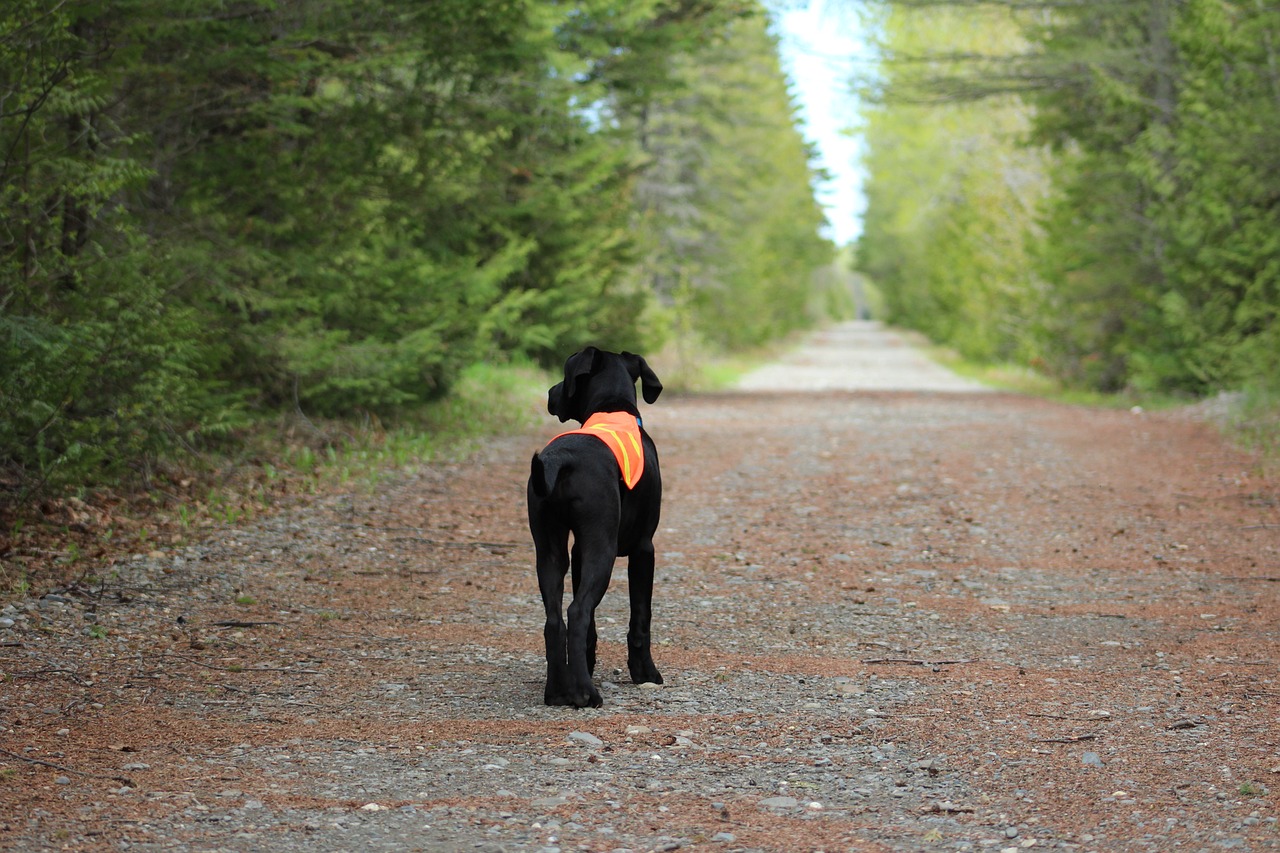
Childproofing Electrical Outlets
Electrical outlets are often a source of danger for curious toddlers, making it essential to childproof them effectively. As parents, we can’t always keep our eyes on our little ones, and that’s where safety measures come into play. Just imagine your child, with their boundless energy and insatiable curiosity, wandering close to an outlet. It’s a scenario that can send shivers down any parent’s spine! Thankfully, there are several strategies to minimize risks associated with electrical outlets, ensuring your home is a safe haven for your little explorers.
One of the simplest yet most effective ways to enhance outlet safety is by using outlet covers and safety plugs. These devices are designed to prevent children from inserting objects into outlets, which can lead to severe electrical shocks. They come in various designs, ensuring that safety doesn’t compromise aesthetics in your home. For instance, some outlet covers blend seamlessly with your decor, making them both functional and visually appealing.
Outlet covers are small devices that fit over the outlets, creating a barrier that is difficult for little fingers to navigate. Not only do they provide a physical barrier, but they also act as a reminder for parents to monitor their child's interactions with electrical appliances. When selecting outlet covers, look for those that are easy to install and fit snugly. A loose cover can be just as dangerous as having no cover at all!
There are multiple types of outlet covers available, including:
- Sliding Covers: These covers slide open when you need to use the outlet and close securely afterward, providing a convenient yet safe solution.
- Tamper-Resistant Outlets: These outlets have built-in safety features that prevent children from inserting objects into them, making them a permanent solution for childproofing.
Each type offers unique benefits, catering to different safety needs in your home. It’s worth investing time to explore these options and choose the best fit for your household.
Proper installation of outlet covers is crucial for effective childproofing. Here are some tips to ensure they work as intended:
- Make sure the covers fit snugly over the outlets.
- Choose covers that are difficult for children to remove, enhancing overall safety.
- Regularly check the covers to ensure they remain secure and intact.
By following these guidelines, you can significantly reduce the risk of electrical accidents in your home.
In addition to using outlet covers, educating children about electrical safety is vital. Start by teaching them to avoid playing near outlets and to respect electrical appliances. It’s important to instill a culture of safety from a young age. Think of it as teaching them to swim; you wouldn’t just throw them into the deep end without any guidance! Instead, gradually introduce them to the concept of electrical safety, explaining the dangers in a way they can understand.
By implementing these childproofing measures and educating your children, you can create a safer living environment that allows them to explore and learn without the constant threat of electrical hazards. Remember, a secure home is a happy home!
Q1: What age should I start childproofing my electrical outlets?
A1: It's best to start childproofing your electrical outlets before your child begins to crawl, as they are naturally curious and will explore their surroundings.
Q2: Are tamper-resistant outlets worth the investment?
A2: Yes! Tamper-resistant outlets provide a permanent solution to outlet safety and eliminate the need for additional covers.
Q3: How often should I check the outlet covers?
A3: It's a good practice to check outlet covers monthly to ensure they are secure and functioning properly.

Understanding Outlet Covers
When it comes to keeping our little explorers safe, outlet covers play a pivotal role in childproofing our homes. These simple yet effective devices act as a barrier, preventing curious hands from inserting objects into electrical outlets, which can lead to serious injuries or electrical shocks. Imagine your toddler, full of energy and curiosity, drawn to those mysterious holes in the wall. Without proper protection, a moment of distraction could lead to a dangerous accident. That's where outlet covers come to the rescue!
Outlet covers are available in a variety of designs and styles, ensuring that safety doesn’t have to compromise the aesthetics of your home. From basic plastic covers to more decorative options, you can find something that fits seamlessly into your decor. Some covers even feature fun designs that can engage children’s interest without drawing them too close to danger. It’s like putting a friendly face on safety!
Moreover, understanding the different types of outlet covers available is essential for effective childproofing. Here are a few common types:
- Sliding Covers: These covers slide open when an adult needs to access the outlet, but remain securely closed when not in use, providing a convenient solution for busy parents.
- Tamper-Resistant Outlets: These outlets have built-in safety features that prevent foreign objects from being inserted, offering a more permanent solution to outlet safety.
- Pop-Up Covers: Ideal for areas where outlets are frequently used, these covers pop up when needed and retract when not in use, ensuring safety without sacrificing accessibility.
Installing outlet covers is a straightforward process, but it’s crucial to ensure that they fit snugly into the outlet and are difficult for children to remove. Take a moment to check that the covers are securely in place after installation. It’s a small step that can make a huge difference in keeping your home safe. Remember, childproofing is not just about adding devices; it’s about creating a safe environment where children can explore and play without unnecessary risks.
Additionally, educating your children about electrical safety is equally important. While outlet covers provide a physical barrier, teaching kids to respect electrical appliances and to avoid playing near outlets fosters a culture of safety in your home. Encourage open conversations about why certain areas are off-limits and what they should do if they see something unusual. This proactive approach not only protects them but also instills a sense of responsibility and awareness.
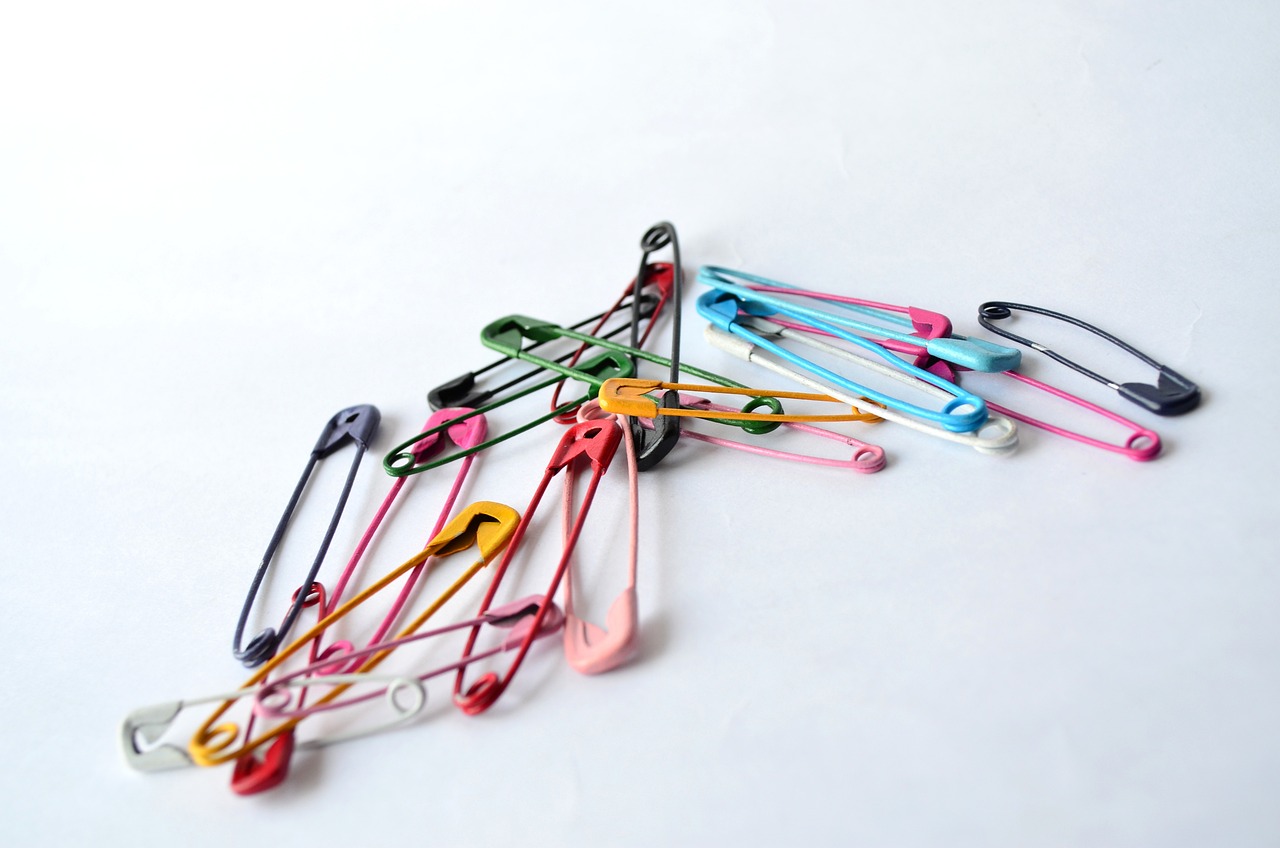
Types of Outlet Covers
When it comes to ensuring the safety of your home, especially for your little explorers, understanding the available is essential. These covers are not just simple plastic pieces; they come in various designs and functionalities that cater to different safety needs. Here’s a closer look at some of the most popular types:
- Sliding Covers: These are designed to slide open when you need to use the outlet and close automatically afterward. This feature makes them incredibly effective in preventing children from tampering with the outlet.
- Tamper-Resistant Outlets: These outlets have built-in shutters that only open when a two-pronged plug is inserted, making it nearly impossible for children to insert objects into the outlet.
- Plug Covers: These are simple plastic caps that fit over unused outlets, effectively blocking access. They are easy to install and remove, making them a popular choice for many parents.
- Decorative Outlet Covers: For those who want safety without sacrificing style, decorative covers come in various designs and colors, allowing you to maintain the aesthetic of your home while keeping it safe.
Choosing the right type of outlet cover depends on your specific needs and the age of your children. For instance, sliding covers are excellent for toddlers who are starting to explore, while tamper-resistant outlets provide a higher level of security for older children who may be more curious and crafty. It's also important to consider the installation process and ensure that the covers fit snugly and are difficult for children to remove.
In conclusion, investing in the right outlet covers is a small yet significant step in childproofing your home. By understanding the different types available, you can make informed decisions that enhance the safety of your living environment.
1. What are the best types of outlet covers for toddlers?
For toddlers, sliding covers and plug covers are highly effective. They provide easy access for adults while keeping curious little hands at bay.
2. Are tamper-resistant outlets worth the investment?
Absolutely! Tamper-resistant outlets offer an extra layer of security and are designed to prevent children from inserting objects, making them a smart choice for any home.
3. How often should I check the outlet covers?
It's a good practice to check outlet covers regularly, especially as your child grows and becomes more mobile. Ensure they are secure and functioning properly.
4. Can I use decorative outlet covers?
Yes! Decorative outlet covers can enhance your home's aesthetic while still providing safety. Just ensure they meet safety standards and are properly installed.

Installation Tips
When it comes to childproofing your electrical outlets, proper installation of outlet covers is not just important—it's essential. You want to ensure that these covers fit snugly and are difficult for children to remove. Think of it as putting on a seatbelt; it needs to be secure to do its job effectively. If you're dealing with sliding covers, make sure they slide smoothly without being too loose. On the other hand, tamper-resistant outlets should be installed by a professional to guarantee they meet safety standards.
Before you start the installation process, gather all the necessary tools. A simple screwdriver may suffice, but depending on the type of outlet cover, you might need additional tools. It's always a good idea to read the manufacturer's instructions carefully. This will not only give you a clear understanding of how to install the covers but will also highlight any specific safety features that you might overlook.
Another tip is to check your outlets regularly. Just like you would check the batteries in smoke detectors, inspecting your outlet covers will help ensure they remain effective over time. If you notice any signs of wear or if a cover seems loose, replace it immediately. Remember, a little vigilance can go a long way in keeping your little ones safe!
Here’s a quick summary of the key points to remember during installation:
- Ensure covers fit snugly and are difficult for children to remove.
- Follow the manufacturer's instructions carefully.
- Regularly inspect outlet covers for wear and tear.
By paying attention to these details, you can significantly enhance the safety of your home and provide peace of mind for you and your family. It's all about creating a secure environment where your children can explore and learn without the constant worry of electrical hazards.
Q: How often should I check my outlet covers?
A: It's a good practice to check your outlet covers every few months, especially if you have active toddlers. Regular inspections help ensure they remain secure and effective.
Q: Can I install outlet covers myself?
A: Yes, most outlet covers can be installed easily with basic tools. However, if you're unsure or if you're using tamper-resistant outlets, consider hiring a professional electrician.
Q: Are all outlet covers the same?
A: No, there are various types of outlet covers, including sliding covers and tamper-resistant outlets, each designed to meet different safety needs. Choose the type that best fits your home and lifestyle.
Q: What should I do if my child removes an outlet cover?
A: If you find that your child has removed an outlet cover, replace it immediately and consider using additional safety measures, such as furniture placement to block access.

Electrical Safety Practices
When it comes to ensuring the safety of your little ones around electrical outlets and appliances, it's not just about installing protective covers; it's also about fostering a culture of awareness and respect for electrical safety. Children are naturally curious, and their inquisitive nature can lead them to explore areas that may pose risks. Therefore, it’s crucial to teach them about the potential dangers associated with electricity.
Start by explaining the importance of staying away from outlets and electrical cords. Use simple analogies that they can relate to, such as comparing electrical outlets to "hungry mouths" that can bite if they get too close. This can help them understand that electricity is something to be respected, not feared. Encourage them to treat electrical appliances with caution, explaining that they should never touch them without adult supervision.
Additionally, consider creating a fun and engaging activity that reinforces these safety practices. For instance, you could set up a little game where they identify safe and unsafe behaviors around electricity. This interactive approach not only makes learning fun but also helps them internalize important safety messages.
Here are some key electrical safety practices to discuss with your children:
- Never insert objects into outlets: Explain that only plugs should go into outlets, and nothing else.
- Stay away from water: Teach them that water and electricity do not mix. They should never use electrical devices near water.
- Ask before using: Encourage them to always ask an adult before using any electrical device.
By incorporating these teachings into your daily routine, you create an environment where children are aware of electrical hazards and know how to avoid them. Remember, the goal is not just to prevent accidents but to empower your children with knowledge that will last a lifetime.
Q: At what age should I start teaching my child about electrical safety?
A: It's never too early to start! You can introduce basic concepts as soon as they begin to explore their surroundings, typically around 1-2 years old. Tailor your discussions to their level of understanding as they grow.
Q: What are some signs that my child understands electrical safety?
A: If your child can identify safe and unsafe behaviors around electrical outlets and appliances and can articulate why certain actions are dangerous, they are likely grasping the concepts well.
Q: How can I reinforce electrical safety practices at home?
A: Regularly discussing safety, practicing scenarios, and modeling safe behavior are great ways to reinforce these practices. Consider using visual reminders, like stickers near outlets, to help them remember.

Safe Furniture Arrangement
When it comes to child safety, the arrangement of furniture in your home plays a pivotal role. Think of your living space as a playground where safety should be the top priority. A well-planned furniture layout can minimize hazards and create a secure environment for your little explorers. Imagine your child darting around the room, full of energy and curiosity. The last thing you want is for them to encounter a tipping hazard or sharp edges. By carefully considering how you position your furniture, you can create a safer haven.
First and foremost, it's essential to ensure that all furniture is stable and secure. Heavy items, such as bookshelves and dressers, should be anchored to the wall. This is especially crucial in homes with active toddlers who love to climb or pull on things. By preventing these pieces from tipping over, you significantly reduce the risk of injury. Imagine a scenario where your child decides to use a bookshelf as a climbing frame—anchoring it can be the difference between a fun adventure and a trip to the emergency room.
Next, consider the placement of furniture. Avoid positioning furniture in a way that creates narrow pathways or tight corners where children could easily trip or fall. Instead, aim for an open layout that allows for plenty of space to move around. This not only ensures safety but also promotes free play, which is essential for your child's development. For instance, placing a coffee table in the center of a play area may seem convenient, but it can quickly become a hazard. Instead, keep play areas clear and open.
In addition to stability and placement, choosing child-friendly furniture is equally important. Opt for items with rounded edges and soft materials to minimize the risk of injury from bumps and falls. Imagine the peace of mind you'll have knowing that your furniture is designed with your child's safety in mind. Furthermore, select non-toxic materials for everything from sofas to toys, ensuring that your home is a healthy environment for your kids.
Lastly, don't forget about the importance of regular checks. Children grow and change quickly, and so do their habits. Periodically reassess your furniture arrangement to ensure it continues to meet safety standards as your child grows. What worked when they were a toddler may not be suitable for a more mobile child. Keep an eye out for any wear and tear on furniture that could pose risks, and make adjustments as necessary to maintain a safe space.
In summary, a safe furniture arrangement is about more than just looks—it's about creating an environment where your children can explore and play without unnecessary risks. By anchoring heavy items, ensuring open pathways, choosing child-friendly designs, and regularly reassessing your layout, you can create a space that’s both functional and safe. After all, a happy home is one where parents can relax, knowing their little ones are safe and sound.
- How can I secure heavy furniture? - Use brackets and straps to anchor heavy furniture to the wall, especially in rooms where children play.
- What types of furniture are safest for children? - Look for furniture with rounded edges and made from non-toxic materials to minimize injury risks.
- How often should I reassess my furniture arrangement? - It’s a good idea to check your furniture layout every few months or whenever your child reaches a new developmental stage.
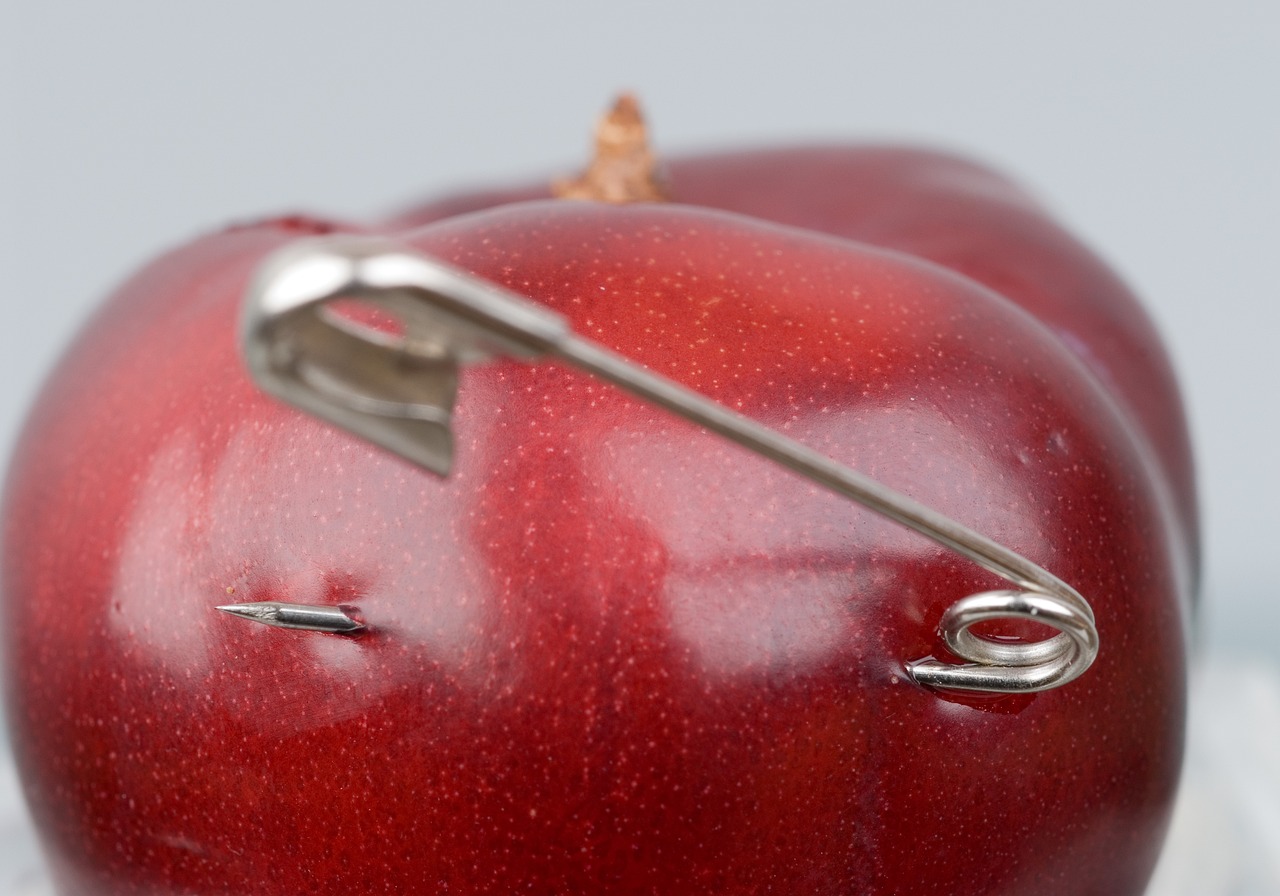
Securing Heavy Furniture
When it comes to child safety, securing heavy furniture is a critical step that often gets overlooked. Imagine your little one, full of energy and curiosity, exploring every nook and cranny of your home. Now, picture a tall bookshelf or a heavy dresser that could easily topple over with just a little tug. The thought alone can send chills down any parent's spine! That's why anchoring heavy furniture to the walls is not just a precaution; it's an absolute necessity.
Heavy furniture, such as bookshelves, dressers, and entertainment centers, can pose serious risks if not secured properly. Children are naturally inquisitive, and their tendency to climb or pull on furniture can lead to devastating accidents. By anchoring these pieces to the wall, you create a stable environment that minimizes the risk of tipping. It’s like putting a seatbelt on your child while driving; it’s a simple yet effective measure that can save lives.
Here are some essential tips for securing heavy furniture:
- Use Straps or Brackets: Invest in furniture straps or brackets that are designed specifically for anchoring. These can be easily installed and provide a strong hold.
- Choose the Right Wall Anchors: Depending on your wall type—drywall, plaster, or brick—select appropriate anchors to ensure a secure fit.
- Regularly Check Stability: Periodically check the secured furniture for any signs of loosening or wear, and tighten or replace anchors as necessary.
Moreover, it’s not just about securing furniture; it’s also about the overall layout of your home. Consider the placement of your heavy furniture in relation to play areas. Keep large items away from areas where children frequently play or explore. This proactive approach ensures that even if they do get too close, the risk of an accident is significantly reduced.
In addition to anchoring, educating your children about the dangers of climbing on furniture is equally important. Teach them that furniture is not a jungle gym and that climbing can lead to serious injuries. Reinforcing this message can help cultivate a natural awareness in your child that enhances their safety.
Remember, securing heavy furniture is just one piece of the puzzle when it comes to creating a safe home for your children. By taking this simple yet effective step, you’re not only protecting your little ones but also giving yourself peace of mind. After all, a safe home is a happy home, and that’s what every parent strives for!
Q: What types of furniture should I secure?
A: It's essential to secure any heavy furniture that could potentially tip over, such as bookshelves, dressers, and entertainment centers.
Q: How do I know if my furniture is secure?
A: Regularly check the stability of secured furniture and ensure that all anchors and straps are tight and in good condition.
Q: Can I use regular screws for anchoring furniture?
A: While you can use screws, it’s recommended to use specific wall anchors and straps designed for securing heavy furniture for maximum safety.
Q: At what age should I start securing furniture?
A: It's wise to start securing furniture as soon as your child begins to crawl or walk, as this is when they become more mobile and curious.
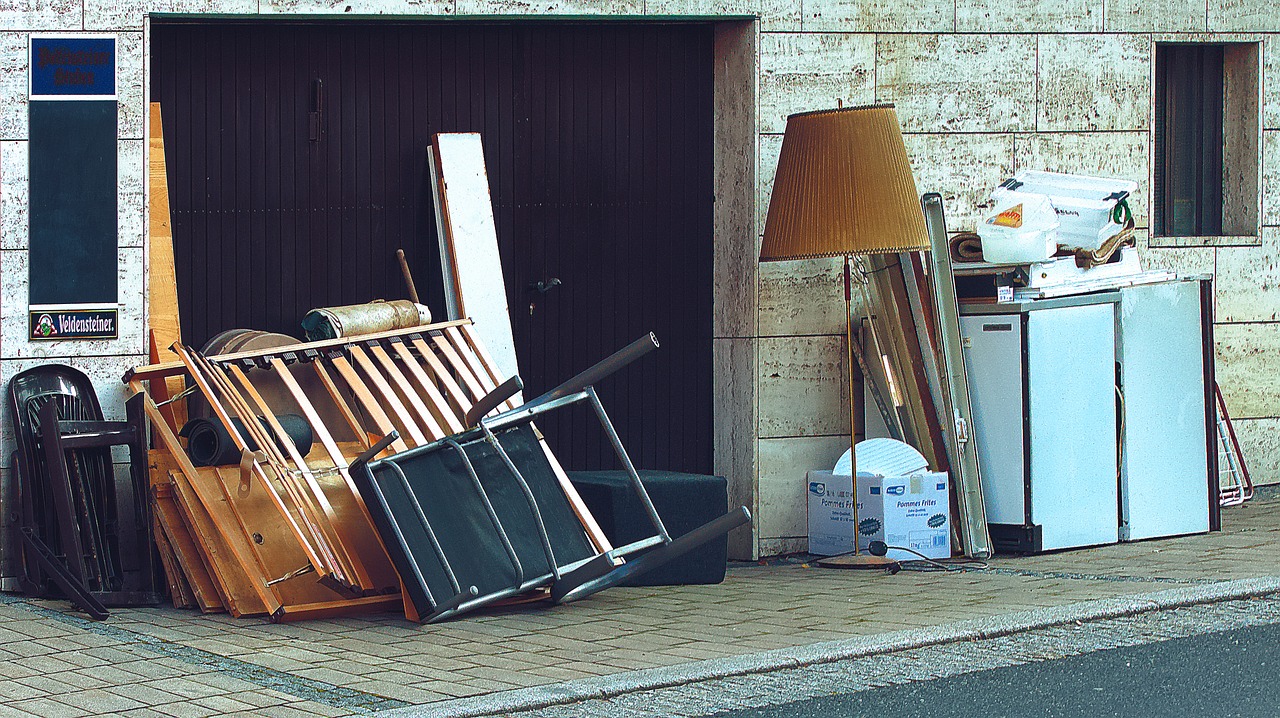
Choosing Child-Friendly Furniture
When it comes to creating a safe haven for your little ones, is crucial. You might think that any piece of furniture will do, but it’s essential to prioritize safety without sacrificing style. Just imagine your toddler running around the house, exploring every nook and cranny. The last thing you want is for them to bump into sharp corners or get hurt by unstable furniture. So, how do you select the right pieces?
First and foremost, look for furniture with rounded edges. Sharp corners can be a recipe for disaster, especially for young children who are still mastering their coordination. Rounded edges not only minimize the risk of injury but also create a more inviting atmosphere for playtime. Additionally, consider furniture made from non-toxic materials. This is particularly important for items like cribs, changing tables, and play furniture, where your child will spend a lot of time. Non-toxic finishes and materials ensure that your little one is not exposed to harmful chemicals.
Another aspect to consider is the stability of the furniture. Heavy pieces should be sturdy enough to withstand the energetic antics of toddlers. For instance, dressers and bookshelves should be anchored to the wall to prevent tipping. You wouldn’t want your child to pull on a drawer and have the entire unit fall over, right? This simple precaution can make a world of difference in keeping your home safe.
In terms of design, look for furniture that is easy to clean. Kids are notorious for making messes, whether it's spilled juice or crayon marks on the couch. Fabrics that are stain-resistant or can be easily wiped down will save you a lot of headaches in the long run. Here’s a quick table to illustrate some key features to look for in child-friendly furniture:
| Feature | Importance |
|---|---|
| Rounded Edges | Minimizes injury risk |
| Non-Toxic Materials | Ensures a safe environment |
| Sturdy Construction | Prevents tipping hazards |
| Easy to Clean Fabrics | Simplifies maintenance |
Lastly, involve your children in the process! Let them pick out pieces that they like, which can help them feel more at home in their space. After all, creating a child-friendly environment is not just about safety; it’s also about making sure your little ones feel comfortable and happy. So, take your time, do your research, and make informed choices that will keep your children safe while also allowing them to express their personalities.
- What materials should I avoid when choosing furniture for my child? It's best to avoid furniture made from particleboard or those containing formaldehyde. Look for solid wood or certified non-toxic materials instead.
- How can I ensure my furniture is stable? Check for stability by ensuring the furniture has a wide base and is anchored to the wall if necessary, especially for tall pieces.
- Are there specific brands known for child-friendly furniture? Yes, many brands focus on child safety, including IKEA, Pottery Barn Kids, and Melissa & Doug.

Installing Safety Gates
When it comes to child safety, one of the most effective measures you can take is installing safety gates. These gates act as physical barriers that prevent children from accessing hazardous areas in your home, such as staircases, kitchens, or rooms with potentially dangerous items. Not only do they provide peace of mind for parents, but they also empower children to explore their environment safely. However, simply having a safety gate is not enough; proper installation is crucial to ensure they function effectively.
Before you rush out to buy a safety gate, it’s essential to understand the different types available. There are primarily two types: pressure-mounted gates and hardware-mounted gates. Pressure-mounted gates are easier to install and remove, making them ideal for temporary use. They fit snugly between walls and don’t require any drilling, which is perfect for rental homes. On the other hand, hardware-mounted gates are more permanent solutions, typically used at the top of stairs or in high-traffic areas. They require screws for installation, ensuring a sturdier fit that can withstand the force of a child pushing against it.
When selecting a safety gate, consider the following factors:
- Height: Choose a gate that is tall enough to prevent your child from climbing over it.
- Material: Safety gates come in various materials, including wood, plastic, and metal. Each has its pros and cons, so pick one that suits your home’s decor and safety needs.
- Opening Mechanism: Look for gates with easy-to-use locking mechanisms that adults can operate with one hand, but are challenging for children to figure out.
Once you’ve chosen the right gate, the next step is installation. Here are some tips to ensure your safety gate is securely mounted:
- Measure the Space: Before installation, measure the area where you plan to place the gate to ensure a proper fit. Consider the width and height to avoid any gaps that a child could slip through.
- Follow the Instructions: Each gate comes with specific installation instructions. Follow these guidelines carefully to ensure the gate is mounted correctly.
- Test for Stability: After installation, test the gate by applying pressure to ensure it doesn’t wobble or move. A secure gate should feel solid and stable.
It’s also important to regularly check the gate for any signs of wear and tear. Children can be surprisingly strong and resourceful, and over time, the hardware may loosen or the gate may become damaged. By routinely inspecting your safety gates, you can ensure they remain effective barriers against potential hazards.
In conclusion, installing safety gates is an essential step in creating a child-friendly home. They not only protect your little ones from accessing dangerous areas but also give you the confidence to manage your household without constant worry. Remember that the right gate, paired with proper installation and regular maintenance, can significantly enhance the safety of your home.
1. Where should I install safety gates?
Safety gates should be installed at the top and bottom of stairs, in doorways leading to hazardous areas (like kitchens), and in rooms where small items may pose a choking hazard.
2. Can I use a safety gate for pets as well?
Absolutely! Many safety gates are designed to keep both children and pets safe. Just ensure that the gate is tall enough to prevent your pet from jumping over it.
3. How do I know if a safety gate is safe?
Look for gates that meet safety standards set by organizations like the Juvenile Products Manufacturers Association (JPMA). Additionally, check customer reviews for insights on durability and safety.

Types of Safety Gates
When it comes to child safety, installing the right type of safety gate is crucial for keeping your little ones out of harm's way. Safety gates come in various styles, each designed to cater to specific needs and situations within your home. Understanding these types can help you make informed decisions that enhance your child's safety while fitting seamlessly into your home decor.
One of the most common types is the pressure-mounted safety gate. These gates are designed to be easily installed without the need for hardware, making them ideal for temporary use or for areas where you don’t want to drill holes, such as doorways or between rooms. They work by using pressure to hold the gate in place against the walls, providing a secure barrier. However, it is essential to ensure that they are installed correctly, as improper installation can lead to accidents.
On the other hand, hardware-mounted safety gates are typically more secure and are recommended for the top of stairs or other high-traffic areas. These gates require drilling into the wall for installation, which makes them a more permanent option. They tend to be sturdier than pressure-mounted gates and can withstand more force, making them ideal for homes with active toddlers who might push against the gate.
For those who need a versatile option, expandable safety gates can be a game-changer. These gates can be adjusted to fit various widths, making them suitable for different openings around your home. They are perfect for creating temporary barriers in larger spaces or when you want to block off areas that are not typically hazardous but still require supervision.
Additionally, walk-through safety gates offer convenience for parents. These gates come with a door that swings open, allowing adults to pass through easily while keeping children safely contained. This type of gate is especially beneficial in high-traffic areas, as it eliminates the need to climb over or remove the gate each time you need to move from one room to another.
Finally, customizable safety gates are available for unique spaces or specific needs. These gates can be tailored to fit unusual openings or can include features such as locking mechanisms or additional height for extra security. While they may come at a higher price point, the peace of mind they provide is often worth the investment.
In summary, choosing the right type of safety gate involves considering where you need it, how often it will be used, and the level of security required. Whether you opt for a pressure-mounted, hardware-mounted, expandable, walk-through, or customizable gate, ensuring that it meets your family's specific needs is vital for maintaining a safe environment for your children.
- What is the best type of safety gate for the top of stairs? Hardware-mounted safety gates are recommended for the top of stairs due to their stability and secure installation.
- Can I use a pressure-mounted gate at the top of stairs? It is not advisable to use pressure-mounted gates at the top of stairs as they can be dislodged easily.
- How do I know if a safety gate is safe? Look for safety certifications, ensure it meets current safety standards, and check for features like a sturdy locking mechanism.
- Are there safety gates that fit irregular spaces? Yes, customizable safety gates can be tailored to fit unusual openings or specific needs in your home.

Proper Installation of Gates
When it comes to child safety, the proper installation of safety gates is not just a recommendation; it's a necessity. A poorly installed gate can easily become a dangerous hazard rather than a protective barrier. To ensure that your gates function effectively, you must follow a few crucial steps during the installation process. First and foremost, identify the locations where you need gates—think about areas like staircases, kitchens, and any other places that could pose a risk to your little explorers.
Next, consider the type of gate that best suits your needs. There are two primary types: pressure-mounted gates and hardware-mounted gates. Pressure-mounted gates are typically easier to install and can be removed without damage to your walls, making them ideal for temporary use. On the other hand, hardware-mounted gates are more secure, as they are attached directly to the wall, which is perfect for high-traffic areas or places where your child might try to climb over.
Once you've chosen your gate, it's time to install it properly. Here are some essential tips to keep in mind:
- Read the Instructions: Always start by carefully reading the manufacturer's instructions. Each gate may have specific installation requirements that must be followed for optimal safety.
- Secure Mounting: If you opt for a hardware-mounted gate, make sure to use the appropriate tools to securely attach it to the wall. This typically involves drilling holes and using screws to ensure a tight fit.
- Check for Stability: After installation, give the gate a good shake to ensure it is stable and won't easily topple over. If it feels loose, adjust the installation until it fits snugly.
- Height Matters: Install the gate at a height that is out of reach of your child. Generally, a height of at least 30 inches is recommended to prevent little ones from climbing over.
Lastly, don't forget to test the gate regularly. Children are curious and can find ways to outsmart even the best safety measures. Make it a habit to check the gate's stability and functionality to ensure it remains a reliable barrier against potential dangers. By taking these steps, you can create a safer environment for your children, giving you peace of mind as they explore their world.
Q1: How do I know which type of gate is best for my home?
A1: Consider the locations where you need gates and the level of security required. For high-traffic areas, hardware-mounted gates are often the best choice, while pressure-mounted gates are suitable for temporary use.
Q2: Can I install a safety gate on a staircase?
A2: Yes, but it's crucial to use hardware-mounted gates at the top of stairs for maximum stability and safety. Pressure-mounted gates should only be used at the bottom of stairs.
Q3: How often should I check the safety gates?
A3: It's a good practice to check your gates weekly, especially if your child is actively using them. Regular checks will help you catch any potential issues before they become a safety hazard.
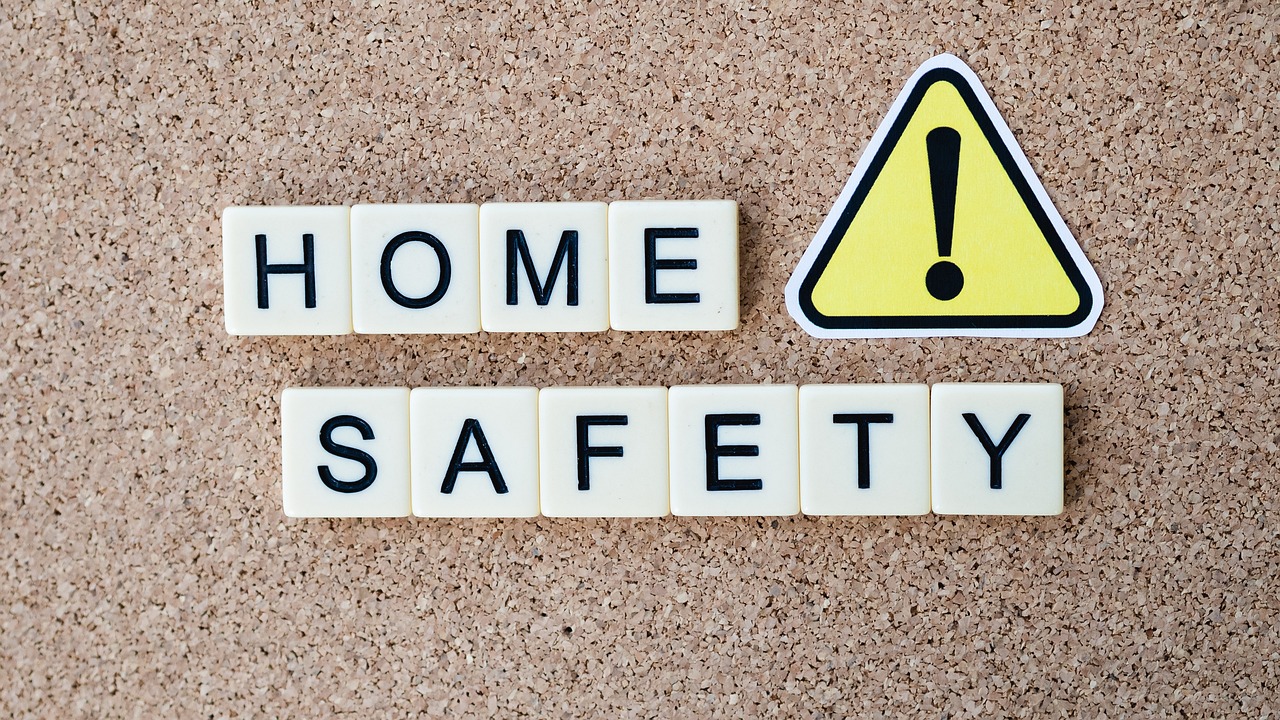
Implementing Fire Safety Measures
Fire safety is a critical aspect of childproofing your home. It’s not just about having a fire extinguisher tucked away in a corner; it’s about creating a comprehensive plan that includes prevention, detection, and response. To begin with, installing smoke detectors in every room is essential. These devices are the first line of defense against fire hazards, alerting you at the first sign of smoke. But remember, simply having smoke detectors is not enough. Regular maintenance is crucial. Test them monthly, replace batteries at least once a year, and consider replacing the entire unit every ten years. This simple routine can be a lifesaver.
Another important measure is having a fire extinguisher easily accessible in key areas of your home, especially in the kitchen where most fires start. It's recommended to have at least one fire extinguisher on each floor of your home. Make sure everyone in your family knows how to use it. You can even conduct a fun family drill to practice this! Furthermore, creating a fire escape plan is vital. Involve your children in the process; it helps them understand what to do in case of an emergency. Draw a map of your home, marking the exits and the meeting point outside. Practice your escape plan regularly so that it becomes second nature.
To enhance your fire safety measures, consider the following:
- Keep flammable materials away from heat sources.
- Never leave cooking unattended.
- Use fire-resistant materials when renovating or decorating.
In addition, educating your children about fire safety is essential. Teach them about the dangers of fire and the importance of staying low to the ground if there’s smoke. Use simple language and analogies they can understand. For example, you might say, "If there’s smoke, it’s like a big, dark cloud that can make it hard to breathe, so we need to get low and crawl under it." By instilling these values early on, you empower them to act responsibly in case of an emergency.
Lastly, consider installing a fire alarm system that can alert you even when you’re not home. These systems can notify you via your smartphone, ensuring that you’re always in the loop. Fire safety is not just a precaution; it’s a necessary part of creating a safe and secure environment for your children. By taking these steps, you can significantly reduce the risks associated with fire hazards in your home.
Q: How often should I test my smoke detectors?
A: It’s recommended to test your smoke detectors monthly to ensure they are functioning properly.
Q: How many fire extinguishers do I need?
A: Ideally, you should have at least one fire extinguisher on each floor of your home, especially in areas like the kitchen and near bedrooms.
Q: What should I include in my fire escape plan?
A: Your fire escape plan should include clear exit routes, a designated meeting place outside, and regular practice sessions with your family.
Q: Are there specific fire safety tips for children?
A: Yes! Teach children to stop, drop, and roll if their clothes catch fire, and to stay low to the ground if there’s smoke. Always explain the dangers of fire clearly.

Smoke Detector Maintenance
Maintaining smoke detectors is not just a good idea; it’s a critical safety measure that can save lives. Think of your smoke detector as the guardian of your home, standing watch over your family while they sleep. But just like any guardian, it needs regular check-ups to ensure it’s functioning properly. The first step in smoke detector maintenance is to test the alarms monthly. This simple action can make a world of difference. Press the test button on the unit, and if you hear a loud beep, congratulations! Your smoke detector is working. If not, it’s time to change the batteries.
Speaking of batteries, it’s essential to replace them at least once a year. A good rule of thumb is to do this when you change your clocks for daylight saving time. This way, you’ll never forget! Additionally, every ten years, you should consider replacing the entire smoke detector unit. Over time, detectors can become less sensitive, and a new unit ensures that your home is adequately protected. Don't forget to check the expiration date on your smoke detector—yes, they have them too!
Another crucial aspect of maintenance is keeping the smoke detector clean. Dust and debris can accumulate on the unit, potentially obstructing its sensors. To clean your smoke detector, simply use a vacuum with a brush attachment to gently remove dust from the surface. You can also wipe it down with a damp cloth. Just be sure to avoid using any harsh chemicals that could damage the unit. Regular cleaning helps ensure that your smoke detector remains sensitive and functional.
Lastly, consider creating a maintenance schedule that includes testing, cleaning, and battery replacement. You can use a simple table or a calendar to track these actions. Here’s a quick example:
| Task | Frequency | Notes |
|---|---|---|
| Test Smoke Detector | Monthly | Press test button |
| Replace Batteries | Yearly | Change during daylight saving time |
| Replace Smoke Detector | Every 10 years | Check expiration date |
| Clean Detector | Quarterly | Vacuum and wipe down |
By being proactive about smoke detector maintenance, you’re not only ensuring the safety of your home but also instilling a sense of security for your family. After all, a well-maintained smoke detector is your first line of defense against fire hazards. So, take the time to care for this essential device—it’s a small effort that can yield life-saving results!
- How often should I test my smoke detector? It’s recommended to test your smoke detector monthly.
- When should I replace the batteries? Replace the batteries at least once a year, ideally when you change your clocks for daylight saving time.
- How long do smoke detectors last? Smoke detectors should be replaced every ten years.
- Can I clean my smoke detector? Yes, you can clean it with a vacuum and a damp cloth, but avoid harsh chemicals.
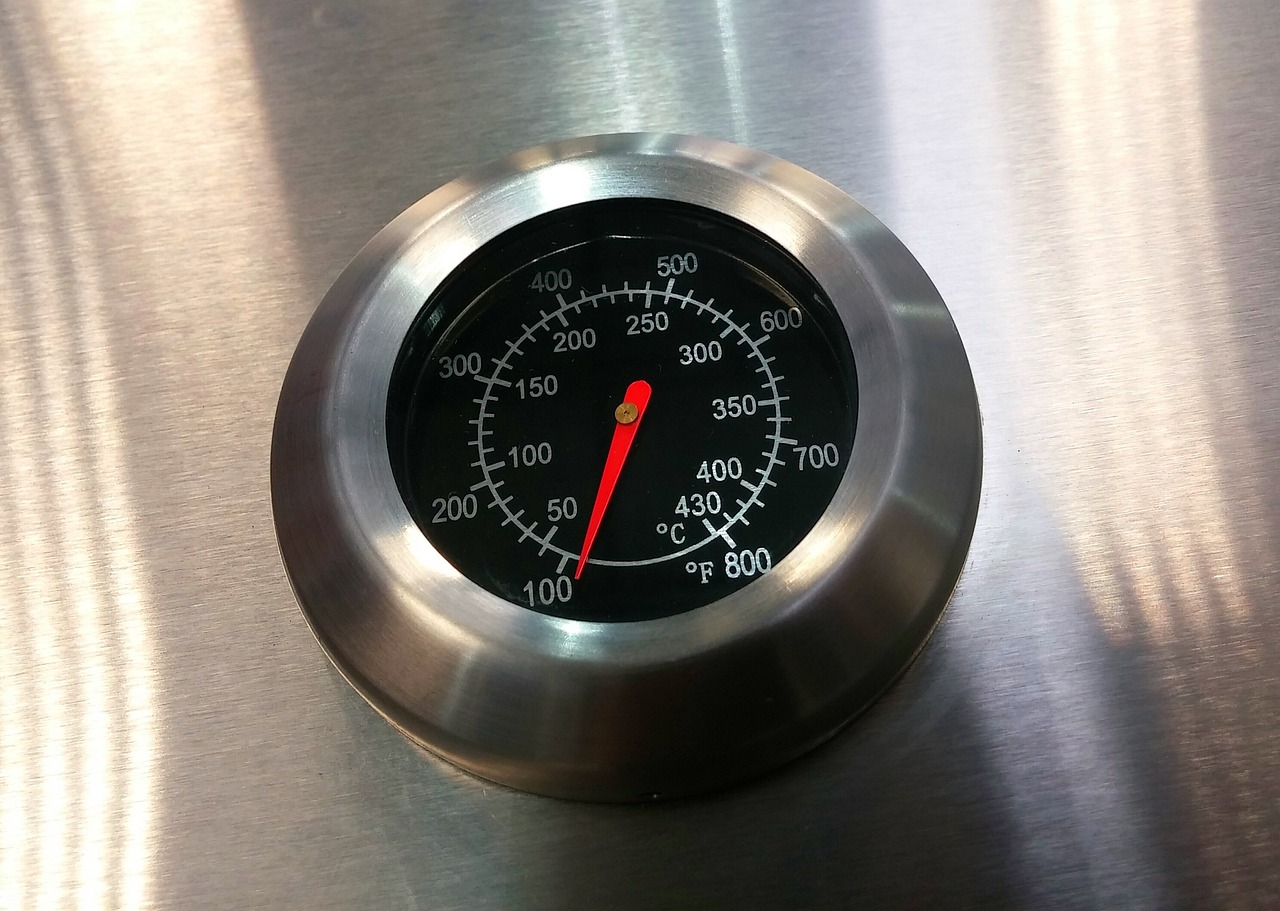
Creating an Escape Plan
This article discusses essential safety features every home should incorporate to ensure a secure environment for children. From physical barriers to technology, learn how to protect your little ones effectively.
Windows and doors pose significant risks for children. Implementing safety locks and window guards can prevent accidents and ensure that your home remains a safe haven for your little ones.
Electrical outlets are often a source of danger for curious toddlers. Using outlet covers and safety plugs can significantly reduce the risk of electrical shocks, making your home safer for children.
Outlet covers are simple devices that prevent children from inserting objects into outlets. They come in various designs, ensuring that safety doesn’t compromise aesthetics in your home.
There are multiple types of outlet covers, including sliding covers and tamper-resistant outlets. Each type offers unique benefits, catering to different safety needs in your home.
Proper installation of outlet covers is crucial for effective childproofing. Ensure they fit snugly and are difficult for children to remove, enhancing overall safety.
In addition to covers, educating children about electrical safety is vital. Teach them to avoid playing near outlets and to respect electrical appliances to foster a culture of safety.
The arrangement of furniture can impact child safety. Ensuring that furniture is stable and strategically placed can prevent tipping hazards and create a safer environment for play.
Heavy furniture should be anchored securely to walls to prevent tipping. This precaution is especially important in homes with active toddlers who may climb or pull on furniture.
Selecting furniture designed with rounded edges and non-toxic materials can significantly reduce injury risk. Prioritizing safety in furniture choices helps create a child-friendly environment.
Safety gates are essential for preventing children from accessing hazardous areas. Strategically placing gates can protect them from stairs, kitchens, and other potentially dangerous zones in your home.
There are various types of safety gates, including pressure-mounted and hardware-mounted options. Each type serves different purposes and should be chosen based on your specific needs.
Installing safety gates correctly is crucial for effectiveness. Ensure they are securely mounted and tested for stability to prevent accidents and ensure child safety.
Fire safety is a critical aspect of childproofing your home. Installing smoke detectors, fire extinguishers, and creating an escape plan can help protect your family in case of emergencies.
Regularly testing and maintaining smoke detectors is vital for ensuring they function properly. Replace batteries regularly and replace units every ten years to keep your home safe.
Creating an effective escape plan is not just a precaution; it's a necessity that can save lives in an emergency. Start by identifying all possible exits in your home, including doors and windows. Make sure everyone in the family knows how to use these exits. It's also important to designate a safe meeting spot outside the house where everyone can gather after escaping. This way, you can quickly account for everyone’s safety.
Consider practicing your escape plan regularly. Just like a fire drill at school, a home drill can help children understand what to do without panicking. You can even make it fun by timing how quickly everyone can get to the meeting spot. Remember, the more familiar they are with the plan, the better prepared they will be in a real emergency.
In addition to practicing the escape plan, discuss what to do in different scenarios. For example, if a fire breaks out in the kitchen, how should they react? What if smoke fills the hall? Teaching children to stay low to the ground and to cover their mouths with a cloth can be life-saving tips. Ultimately, fostering an environment where safety is prioritized will empower your children to act confidently and calmly in emergencies.
Choosing non-toxic materials for home furnishings and cleaning products is essential for child safety. This choice minimizes exposure to harmful chemicals, ensuring a healthier living environment for children.
Understanding labels and certifications can help parents identify non-toxic products. Look for certifications like Greenguard and low-VOC labels to ensure safety in your home.
Implementing a non-toxic environment involves more than just products. Consider air quality, ventilation, and natural cleaning solutions to create a safe space for your children to thrive.
- What are the most important safety features to have in a home with children? Key features include secure windows and doors, childproof electrical outlets, safety gates, and fire safety measures.
- How can I ensure my furniture is safe for my child? Choose furniture with rounded edges, secure heavy items to walls, and avoid sharp corners.
- What should I include in a fire escape plan? Identify exits, designate a meeting spot, and practice the plan regularly with all family members.
- How can I tell if a product is non-toxic? Look for certifications such as Greenguard and low-VOC labels on products.
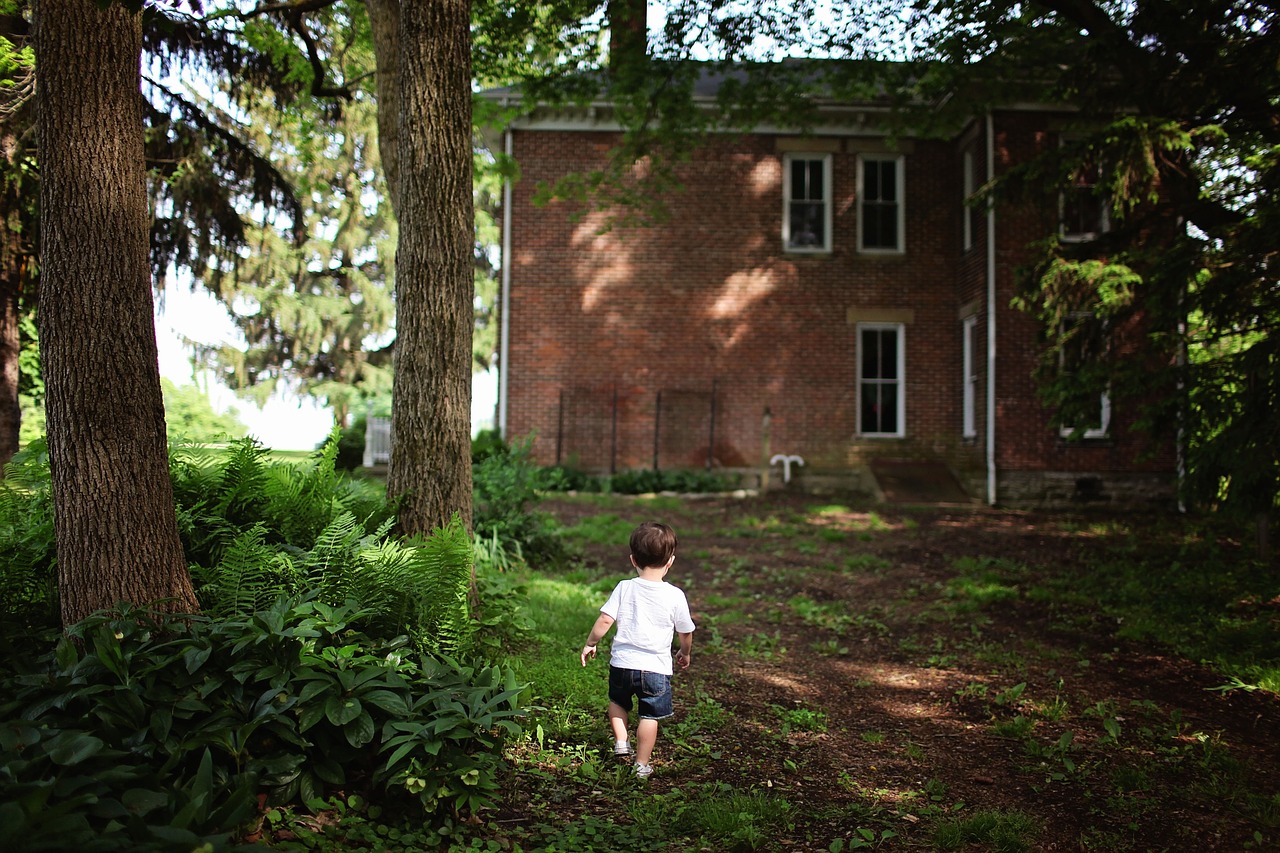
Using Non-Toxic Materials
When it comes to creating a safe haven for your children, one of the most crucial steps is using non-toxic materials in your home. This doesn't just mean avoiding harmful chemicals; it's about fostering a healthy environment where your little ones can thrive without the fear of exposure to dangerous substances. Think of your home as a protective bubble, and the materials you choose as the walls that keep that bubble intact. By opting for non-toxic options, you're not just making a choice; you're making a commitment to your family's health.
So, what exactly are non-toxic materials? In simple terms, these are products that do not contain harmful chemicals or substances that can pose a risk to health. This includes everything from furniture and paints to cleaning supplies and toys. Many parents might not realize that even the air quality in their homes can be affected by the materials they use. For instance, traditional paints can emit volatile organic compounds (VOCs) that are harmful when inhaled. Instead, look for paints labeled as low-VOC or no-VOC to keep the air in your home fresh and safe.
Identifying non-toxic products can feel like navigating a maze, but it doesn't have to be overwhelming. Start by paying attention to labels. Products that are certified by organizations such as Greenguard or have low-VOC labels are excellent choices. These certifications indicate that the products have been tested for harmful emissions and have passed strict safety standards. When shopping for furniture, look for pieces made from solid wood rather than particleboard, which can contain harmful adhesives. Here's a quick comparison of materials:
| Material | Non-Toxic? | Notes |
|---|---|---|
| Solid Wood | Yes | Durable and free from harmful chemicals. |
| Particleboard | No | Often contains toxic adhesives. |
| Latex Paint | Yes | Low in VOCs and safe for indoor use. |
| Oil-Based Paint | No | High in VOCs, harmful when inhaled. |
| Natural Cleaning Products | Yes | Safe for kids and pets, eco-friendly. |
Creating a non-toxic environment goes beyond just selecting the right products. It's about establishing a holistic approach to your family's well-being. Consider factors such as air quality and ventilation. Regularly open windows to let in fresh air and reduce indoor pollutants. You might also want to incorporate natural cleaning solutions, like vinegar and baking soda, which are not only effective but also safe for your children. Imagine cleaning your home without worrying about what chemicals linger in the air—it's a game changer!
In conclusion, using non-toxic materials is a vital step in ensuring your home is a safe space for your children. It's about making informed choices, understanding what goes into the products you use, and creating an environment where your family can flourish. Remember, every small change can lead to a big impact on your children's health and safety.
- What are non-toxic materials? Non-toxic materials are products that do not contain harmful chemicals and are safe for human health.
- How can I identify non-toxic products? Look for certifications like Greenguard and low-VOC labels on products.
- Are there safe alternatives to traditional cleaning products? Yes, natural cleaning solutions like vinegar and baking soda are effective and safe.
- Why is air quality important in a child’s environment? Poor air quality can lead to respiratory issues and other health problems, especially in young children.
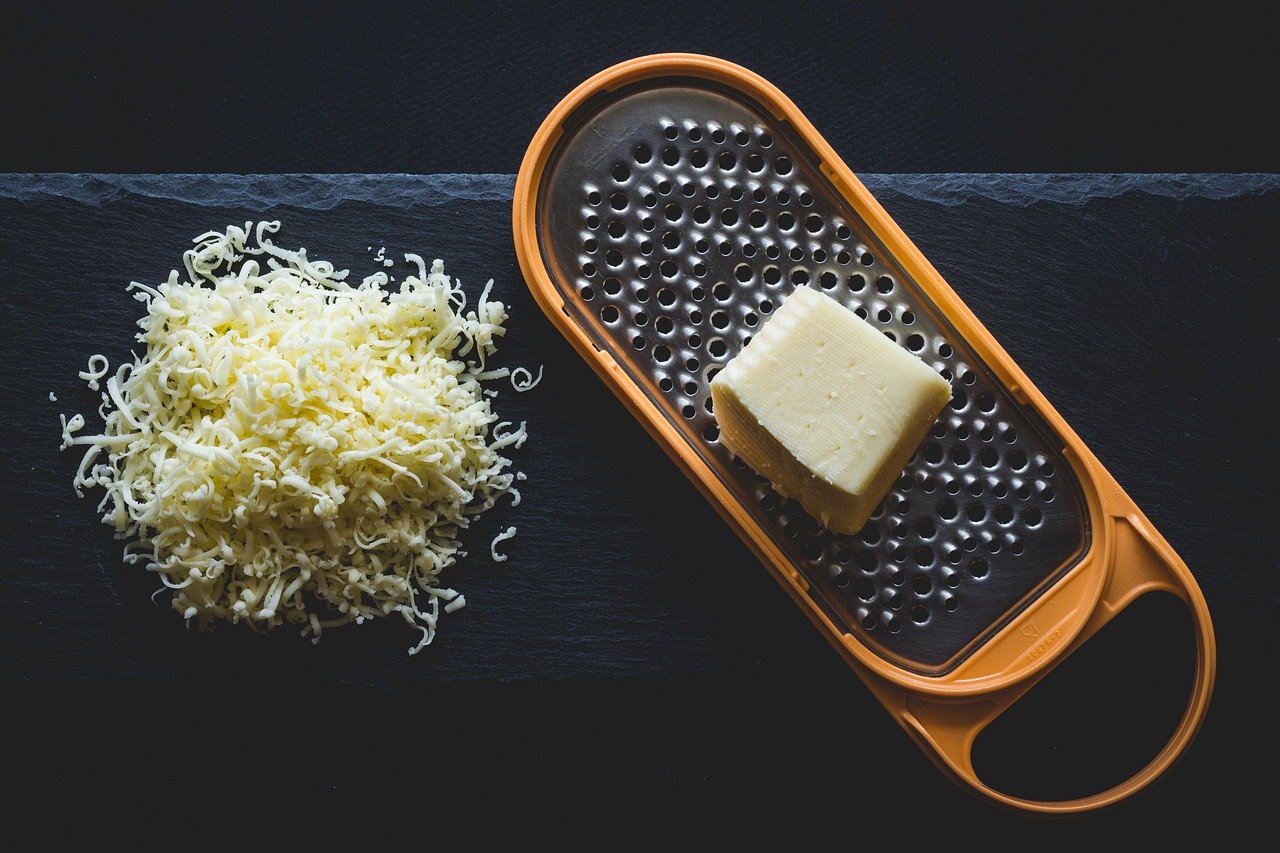
Identifying Non-Toxic Products
When it comes to ensuring the safety and well-being of your children, choosing non-toxic products is paramount. But how do you identify these safe options amidst a sea of products that claim to be "safe" or "natural"? The first step is to become a savvy shopper by understanding labels and certifications that highlight non-toxic materials. For instance, look for products that carry certifications such as Greenguard, which indicates that the product has been tested for harmful emissions, or low-VOC labels that signify low levels of volatile organic compounds, which can be harmful to health.
Additionally, it's essential to be aware of the ingredients listed on product labels. Familiarize yourself with common toxic substances that are often found in household items. Here are a few to watch out for:
- Phthalates: Often found in plastics, these chemicals can disrupt hormonal systems.
- Formaldehyde: Used in many household products, it can cause respiratory issues.
- Lead: Sometimes present in paints and toys, lead exposure can severely affect development.
Another effective strategy is to research brands that prioritize safety and sustainability. Many companies are now transparent about their manufacturing processes and ingredient sourcing. Websites and resources that focus on product safety can provide valuable insights and reviews. Always check for third-party testing to ensure that the products meet safety standards.
Lastly, consider the environmental impact of the products you choose. Non-toxic products often come from sustainable sources and are biodegradable. This not only protects your children but also contributes to a healthier planet. By making informed choices, you can create a safe, non-toxic environment for your children to grow and thrive.
Q: What are some common non-toxic brands I can trust?
A: Brands like Seventh Generation, Mrs. Meyer's Clean Day, and Babyganics are known for their commitment to non-toxic ingredients and sustainability.
Q: How can I ensure the air quality in my home is safe?
A: Regularly ventilate your home, use air purifiers, and choose houseplants known for improving air quality, such as spider plants and peace lilies.
Q: Are all natural products non-toxic?
A: Not necessarily. While many natural products are safer alternatives, it’s crucial to read labels and check for certifications to ensure they are genuinely non-toxic.
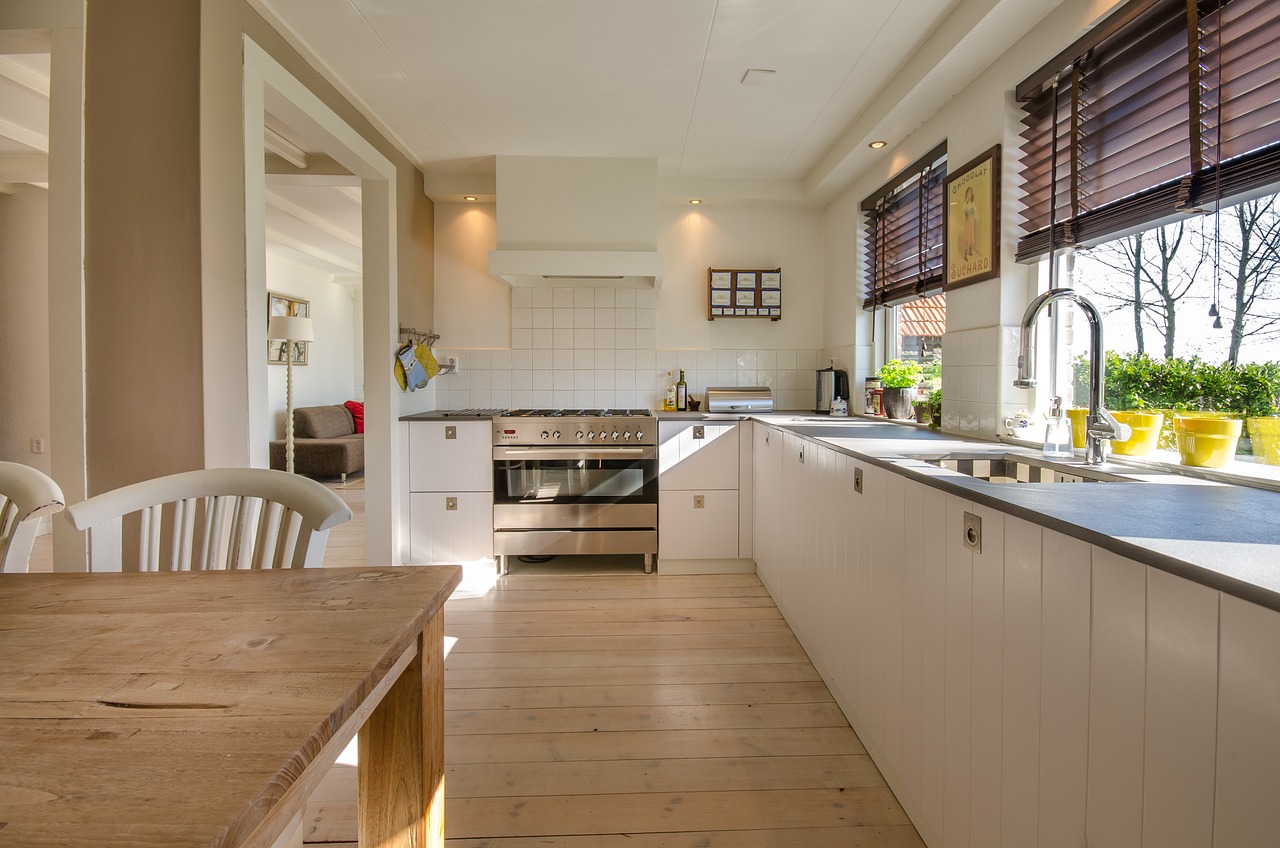
Creating a Non-Toxic Environment
Creating a non-toxic environment for your children is not just a trend; it's a necessity in today's world. With the increasing awareness of the harmful effects of chemicals found in everyday products, parents are more determined than ever to ensure their homes are safe havens. The first step in this journey is to evaluate everything that enters your home, from furniture to cleaning supplies. This means opting for products that are labeled as non-toxic, organic, or free from harmful substances.
But what does it really mean to create a non-toxic environment? It goes beyond just selecting the right products. It involves a holistic approach to your living space. For instance, consider the air quality in your home. Poor air quality can lead to respiratory issues, especially in young children. To combat this, ensure proper ventilation by opening windows regularly and using air purifiers equipped with HEPA filters. These devices can significantly reduce indoor pollutants, making the air cleaner and safer for your little ones.
Additionally, think about the materials used in your home. When choosing furnishings, look for items made from natural materials such as wood, cotton, or wool, which are less likely to emit harmful chemicals compared to synthetic alternatives. For example, many furniture manufacturers now offer products that are free from volatile organic compounds (VOCs), which can contribute to indoor air pollution. By selecting these types of products, you not only enhance your home’s aesthetic appeal but also prioritize the health of your family.
When it comes to cleaning your home, many conventional cleaning products contain harsh chemicals that can be harmful to children. Instead, consider using natural cleaning solutions. You can easily create effective cleaners using common household items like vinegar, baking soda, and lemon juice. Not only are these alternatives safer, but they are also cost-effective and environmentally friendly.
In summary, creating a non-toxic environment is about making informed choices that protect your children from harmful substances. By focusing on air quality, selecting natural materials, and using safe cleaning products, you can transform your home into a sanctuary that promotes health and well-being. Remember, every small change you make contributes to a safer space for your children to grow and thrive.
- What are VOCs, and why are they harmful?
VOCs, or volatile organic compounds, are chemicals that can evaporate into the air and contribute to indoor air pollution. They can cause respiratory issues and other health problems, especially in children. - How can I tell if a product is non-toxic?
Look for certifications like Greenguard or low-VOC labels. These indicate that the product has been tested for harmful emissions and is safer for indoor use. - What natural ingredients can I use for cleaning?
Common natural cleaning ingredients include vinegar, baking soda, lemon juice, and essential oils. These can effectively clean surfaces without harmful chemicals.
Frequently Asked Questions
- What are the best ways to secure windows and doors for child safety?
To enhance child safety, install safety locks on doors and window guards on windows. These measures prevent little ones from accidentally opening windows or doors, ensuring they stay safe indoors.
- How can I effectively childproof electrical outlets?
Using outlet covers and safety plugs is essential for childproofing electrical outlets. These devices prevent children from inserting objects into the outlets, significantly reducing the risk of electrical shocks.
- What types of outlet covers are available?
There are several types of outlet covers, including sliding covers and tamper-resistant outlets. Each type offers unique protection, so choose the one that best meets your child's safety needs.
- How should I arrange furniture to ensure child safety?
Arrange furniture in a way that minimizes tipping hazards. Use stable furniture and anchor heavy pieces to the wall to prevent accidents, especially in homes with active toddlers.
- What types of safety gates should I consider?
There are pressure-mounted and hardware-mounted safety gates. Choose the type based on where you need to install them, like at the top of stairs or in doorways, to keep your child safe from hazardous areas.
- How can I implement fire safety measures in my home?
Install smoke detectors and fire extinguishers, and create an escape plan for your family. Regularly test your smoke detectors and practice your escape plan to ensure everyone knows what to do in case of a fire.
- What are non-toxic materials, and why are they important?
Non-toxic materials are those that do not release harmful chemicals into the environment. Choosing non-toxic furnishings and cleaning products is crucial for creating a safe and healthy living space for your children.
- How can I identify non-toxic products for my home?
Look for certifications like Greenguard and low-VOC labels on products. These indicators help you choose safer options for your home, ensuring a healthier environment for your little ones.

